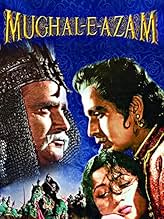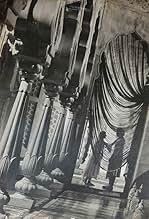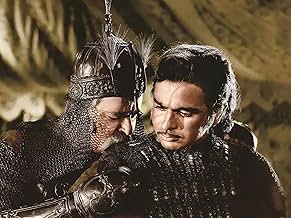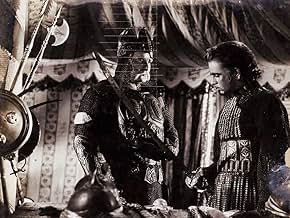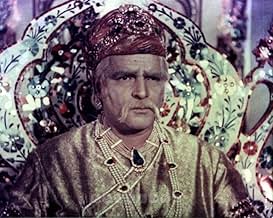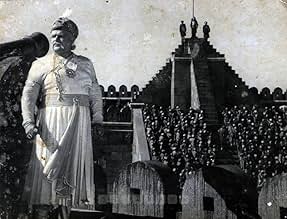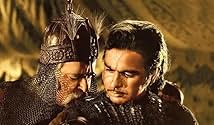VALUTAZIONE IMDb
8,1/10
9292
LA TUA VALUTAZIONE
Ambientato alla fine del XVI secolo nel periodo Moghul dell'India, questa è la vita sfortunata del principe Saleem, figlio dell'imperatore regnante Akbar, che si innamora della schiava danza... Leggi tuttoAmbientato alla fine del XVI secolo nel periodo Moghul dell'India, questa è la vita sfortunata del principe Saleem, figlio dell'imperatore regnante Akbar, che si innamora della schiava danzante Anarkali.Ambientato alla fine del XVI secolo nel periodo Moghul dell'India, questa è la vita sfortunata del principe Saleem, figlio dell'imperatore regnante Akbar, che si innamora della schiava danzante Anarkali.
- Premi
- 3 vittorie e 3 candidature totali
Prithviraj Kapoor
- Emperor Akbar
- (as Prithviraj)
Ajit Khan
- Durjan Singh
- (as Ajit)
Jillo
- Anarkali's Mother
- (as Jillo Bai)
Sheila Dalaya
- Suraiya
- (as Sheela Delaya)
Tabassum Govil
- A Tawaif
- (as Baby Tabassum)
Recensioni in evidenza
Mughal-e-Azam is indeed a colossal of a movie and its spell binding appeal and courtly grandeur has been further enhanced by the recently released color version.
Dilip Kumar, the icon of Indian Cinema and its first super star as well, has rendered complete resonance to the hedonistic persona of prince Saleem. The love travails of the myth of Anarkali have been splendidly captured on the tinsel screen through the superb portrayal by both, Madhu Bala and legendary Dilip Kumar. Besides, Pirthvi RajKapoor has also projected the required prestige and magnitude to the role of Emperor Akbar. It is worth watching, another time in color scope.
Dilip Kumar, the icon of Indian Cinema and its first super star as well, has rendered complete resonance to the hedonistic persona of prince Saleem. The love travails of the myth of Anarkali have been splendidly captured on the tinsel screen through the superb portrayal by both, Madhu Bala and legendary Dilip Kumar. Besides, Pirthvi RajKapoor has also projected the required prestige and magnitude to the role of Emperor Akbar. It is worth watching, another time in color scope.
10veeru
Haha -- when I see comments that put Kuch Kuch Hota Hain or any other formulaic hindi flick as "the best film ever" they obviously didn't see K. Asif's vision of Mughal-e-Azam. From Prithviraj Kapoor's magnificent rendering of the imposing Emperor Akbar to Dalip Kumar's obvious love for the spectacular Madhubhala. The exquisite Urdu dialogues is of course not for the neophyte. But for those that can appreciate the finer things in life -- not some cloying Hum Apke Hain Kaun or Shah Rukh Khan's obsession with bleeding and overacting in every single film -- Mughal-e-Azam fits the bill perfectly.
This film is by far one of the best, I have seen. One is sure to be mesmerized by the love affair, the Mughal Emperor and the India of that time. The film being in Urdu language also adds originality and aura. The dialogs and direction is superb. The voice of late Prithvi Raj Kapoor as Akbar is beyond compare. Salim, played by Dilip Kumar is one of his best known acting and film. Madhubala seems great, and I definitely feel, she rivals any modern day actress in her beauty, grace and boldness and courage. I watched the latest 2004 re-release of this film in a theater and the experience was superb. I had earlier watched the movie (earlier release) in television before, but the latest release in colour and Dolby digital sound adds to the experience. Talking about a Hindi film, one definitely has to applaud it's songs. Based on Classical music, the songs adds life to the film and are strongly linked with the story-line as well. The best part I felt as a modern gen. guy is the passion and the customs and respect towards his/her duties and elders and system. Akbar's court was also known his secular principles. He had cordial relations with Rajputs(Hindu) too with his wife Jodha Bai herself being from Rajput clan and Man Singh as the head of his infantry. The movie shows the love and emotions through powerful poetic words (dialoges). This is one of the best parts of this film. One can learn many things from this film and is sure to bring in oneself an increased understanding towards one's duties and sacrifice. A must watch for one and for all ... and do watch with keenness and each word spoken in the movie is worth it.
I haven't seen the black and white original of Mughal E Azam since the '80's, but I recently saw the restored revived colourised 2004 re-release for the first time and was astounded by the results. I'm not a believer in messing around with the originals, but bearing in mind director Asif always wanted to make the whole film in colour but didn't have enough money the "final" product is amazing to see - such is technology! It was incredibly expensive to make as it was, the restoration process must have cost a fabulous amount too.
Seminal Indian epic purporting to deal with events from about 400 years ago around Prince Saleem (Dilip Kumar) falling in love with a court dancer Anarkali (Madhubala) to his father Akbar's utter opposition and eventually causing a rift leading to all out war. The drama and war spectacle scenes are memorable enough, with thousands of humans and animals as extras, and the music is uniformly superb too. But it's Pyar Kiya To Darna Kya (If I have loved someone>why should I be afraid?) sung by Anarkali (Lata) to the 2 of them in the Hall Of Mirrors that is absolutely stunning - I will have to get the original and compare, because the remaster seems to have turned this song into something even more magical and mesmerising than I remembered. It took Naushad and Shakeel Badayuni one night to compose music and lyrics so timeless - a colourful piece of poetry in motion, with the insistent kaleidoscopic climax added by Asif. Awesome! According to the legend it was supposed to have an unhappy ending - needless to say I'm glad it was altered here to a happy one after such a roller-coaster ride!
A tremendous work of Art, showing the very best of Indian cinema.
Seminal Indian epic purporting to deal with events from about 400 years ago around Prince Saleem (Dilip Kumar) falling in love with a court dancer Anarkali (Madhubala) to his father Akbar's utter opposition and eventually causing a rift leading to all out war. The drama and war spectacle scenes are memorable enough, with thousands of humans and animals as extras, and the music is uniformly superb too. But it's Pyar Kiya To Darna Kya (If I have loved someone>why should I be afraid?) sung by Anarkali (Lata) to the 2 of them in the Hall Of Mirrors that is absolutely stunning - I will have to get the original and compare, because the remaster seems to have turned this song into something even more magical and mesmerising than I remembered. It took Naushad and Shakeel Badayuni one night to compose music and lyrics so timeless - a colourful piece of poetry in motion, with the insistent kaleidoscopic climax added by Asif. Awesome! According to the legend it was supposed to have an unhappy ending - needless to say I'm glad it was altered here to a happy one after such a roller-coaster ride!
A tremendous work of Art, showing the very best of Indian cinema.
When one thinks of great movies they remember the classics such as gone with the wind, Ben hur etc... but let us not forget one of the greatest cinematic triumphs of Hindi Cinema Mughal-e-Azam a film set in the times of the great Moughul Empire. Having seen both the part B/W and Colour and the remastered full colour version I can truly say that the colourised version truly brings out the true glory of this amazing classic putting it in a league way beyond the Classics of today. The dialogue is simply superb and the acting truly amazing modern filmmakers could learn thing or two about acting. The cinematography is simply stunning for a movie of its time. the grandeur and opulence of the sets really comes out in full colour. The story though not very relevant for modern times shows the views and attitudes of India's past. a truly great film to watch...
Lo sapevi?
- QuizThe song "Pyar Kiya To Darna Kiya" has an unusual history to it: it cost Rs. 10 million at a time when a film would be made for less than a million; it was written and re-written 105 times by the lyricist, Shakeel Badayuni, before the music director, Naushad, could approve of it; it was shot in the renowned Sheesh Mahal (Palace of Mirrors); and in those days of sound recording, editing and mixing, as there was no way to provide the reverberation of sound, Naushad had playback singer Lata Mangeshkar sing the song in a studio bathroom.
- BlooperMusic and dancing styles from the 19th century were depicted, although the story takes place in the 16th century. For example, Thumri, a semi-classical music form developed in the 19th century, is adopted in a dance sequence in Kathak style, which is a 16th-century dance form.
- Curiosità sui crediti2004: The End Credits play the song 'Pyaar Kiya To Darna Kya' and its 1960 end credits are adjacent to the 2004 (Technicians) credits.
- Versioni alternativeThe original version is in B/W and only one song 'Pyar kiya to darna kya...' was shot in color as most of the film (by the time color technology was available) was complete. This was at the end of almost 10 years that the film was being completed. However, the year 2004 re-release is re-mastered from the original B/W version to Color with Dolby Digital sound and some visual enhancements.
- ConnessioniFeatured in Century of Cinema: And the Show Goes On: Indian Chapter (1996)
I più visti
Accedi per valutare e creare un elenco di titoli salvati per ottenere consigli personalizzati
- How long is Mughal-E-Azam?Powered by Alexa
Dettagli
- Data di uscita
- Paese di origine
- Sito ufficiale
- Lingue
- Celebre anche come
- The Great Mughal
- Azienda produttrice
- Vedi altri crediti dell’azienda su IMDbPro
Botteghino
- Budget
- 15.000.000 INR (previsto)
- Lordo Stati Uniti e Canada
- 161.434 USD
- Fine settimana di apertura Stati Uniti e Canada
- 60.258 USD
- 3 apr 2005
- Lordo in tutto il mondo
- 161.434 USD
- Tempo di esecuzione3 ore 17 minuti
- Colore
- Mix di suoni
- Proporzioni
- 1.37 : 1
Contribuisci a questa pagina
Suggerisci una modifica o aggiungi i contenuti mancanti



